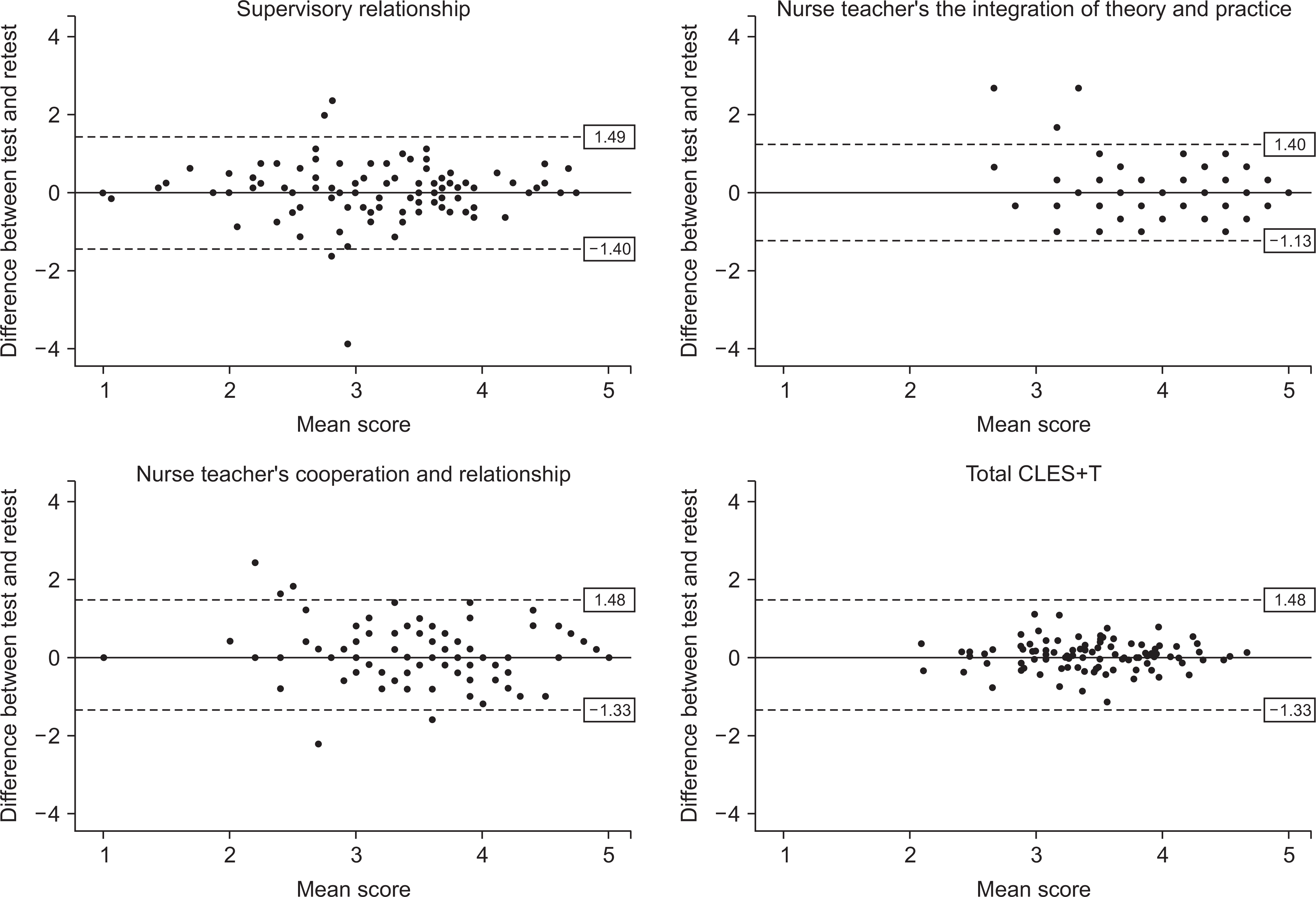1. Chan D. Development of the clinical learning environment inventory: Using the theoretical framework of learning environment studies to assess nursing students’perceptions of the hospital as a learning environment. Journal of Nursing Education. 2002; 41(2):69–75.
2. Mansutti I, Saiani L, Grassetti L, Palese A. Instruments evaluating the quality of the clinical learning environment in nursing education: A systematic review of psychometric properties. International Journal of Nursing Studies. 2017; 68:60–72. https://doi.org/10.1016/j.ijnurstu.2017.01.001.

3. Papp I, Markkanen M, von Bonsdorff M. Clinical environment as a learning environment: Student nurses’ perceptions concerning clinical learning experiences. Nurse Education Today. 2003; 23(4):262–268. https://doi.org/10.1016/S0260-6917(02)00185-5.

4. Kown IS, Seo YM. Nursing students’needs for clinical nursing education. The Journal of Korean Academic Society of Nursing Education. 2012; 18(1):25–33. https://doi.org/10.5977/jkasne.2012.18.1.025.
5. Kim EY, Yang SH. Effects of clinical learning environment on clinical practice stress and anxiety in nursing students. Journal of Korean Academy of Nursing Administration. 2015; 21(4):417–425. https://doi.org/10.11111/jkana.2015.21.4.417.

6. Kim K. Affecting factors on competence of clinical practice of nursing students. The Korean Journal of Stress Research. 2014; 22(2):55–65. https://doi.org/10.17547/kjsr.2014.22.2.55.

7. Saarikoski M, Isoaho H, Warne T, Leino-Kilpi H. The nurse teacher in clinical practice: Developing the new sub-dimension to the clinical learning environment and supervision (CLES) scale. International Journal of Nursing Studies. 2008; 45(8):1233–1237. https://doi.org/10.1016/j.ijnurstu.2007.07.009.

8. Saarikoski M, Leino-Kilpi H. The clinical learning environment and supervision by staff nurses: Developing the instrument. International Journal of Nursing Studies. 2002; 39(3):259–267. https://doi.org/10.1016/S0020-7489(01)00031-1.

9. Song J, Kim M. Study on clinical education for nursing in hospitals in Korea. The Journal of Korean Academic Society of Nursing Education. 2013; 19(2):251–264. https://doi.org/10.5977/jkasne.2013.19.2.251.

10. Chan DS, Ip WY. Perception of hospital learning environment: A survey of Hong Kong nursing students. Nurse Education To- day. 2007; 27(7):677–684. https://doi.org/10.1016/j.nedt.2006.09.015.

11. Dunn SV, Burnett P. The development of a clinical learning environment scale. Journal of Advanced Nursing. 1995; 22(6):1166–1173. https://doi.org/10.1111/j.1365-2648.1995.tb03119.x.

12. Chung MS, Park JS, Ryu E, Shin G, Jun HY, Kim BJ. Teaching effectiveness and adequacy of practical training in nursing students. The Journal of Korean Academic Society of Nursing Education. 2015; 21(4):550–560. https://doi.org/10.5977/jkasne.2015.21.4.550.

13. Han J. Nursing students’perceptions of clinical learning environment (CLE). Journal of the Korean Data Analysis Society. 2010; 12(5):2595–2607.
14. Comrey AL, Lee HB. A first course in factor analysis. 2nd ed. Hillsdale (NJ): Lawrence Erlbaum Associates;1992. p. 217.
15. MacCallum RC, Browne MW, Sugawara HM. Power analysis and determination of sample size for covariance structure modeling. Psychological Methods. 1996; 1(2):130–149. https://doi.org/10.1037/1082-989X.1.2.130.

16. Giraudeau B, Mary JY. Planning a reproducibility study: How many subjects and how many replicates per subject for an expected width of the 95 per cent confidence interval of the intraclass correlation coefficient. Statistics in Medicine. 2001; 20(21):3205–3214. https://doi.org/10.1002/sim.935.

17. Whang SJ. Development and verification of a tool for the nursing students’clinical stress. Journal of the Margaret Pritchard College of Nursing. 2002; 14(1):35–54.
18. World Health Organization. Process of translation and adaptation of instruments [Internet]. Geneva: Author;c2015. [cited 2016 Nov 1]. Available from:. http://www.who.int/substance_abuse/research_tools/translation/en/.
19. Streiner DL, Norman GR, Cairney J. Health measurement scales: A practical guide to their development and use. Oxford: Oxford University Press;2014. p. 30–34. 83-84, 149-156.
20. Lee K, Shin S. Validity of instrument development research in Korean nursing research. Journal of Korean Academy of Nursing. 2013; 43(6):697–703. https://doi.org/10.4040/jkan.2013.43.6.697.

21. Geldhof GJ, Preacher KJ, Zyphur MJ. Reliability estimation in a multilevel confirmatory factor analysis framework. Psychological Methods. 2014; 19(1):72–91. https://doi.org/10.1037/a0032138.

22. Tomietto M, Saiani L, Palese A, Cunico L, Cicolini G, Watson P, et al. Clinical learning environment and supervision plus nurse teacher (CLES+T) scale: Testing the psychometric characteristics of the Italian version. Giornale Italiano di Me-dicina del Lavoro ed Ergonomia. 2012; 34(2 Suppl B):B72–B80.
23. Watson PB, Seaton P, Sims D, Jamieson I, Mountier J, Whittle R, et al. Exploratory factor analysis of the Clinical Learning Environment, Supervision and Nurse Teacher Scale (CLES+T). Journal of Nursing Measurement. 2014; 22(1):164–180. https://doi.org/10.1891/1061-3749.22.1.164.

24. Iacobucci D, Duhachek A. Advancing alpha: Measuring reliability with confidence. Journal of Consumer Psychology. 2003; 13(4):478–487. https://doi.org/10.1207/S15327663JCP1304_14.

25. Johansson UB, Kaila P, Ahlner-Elmqvist M, Leksell J, Isoaho H, Saarikoski M. Clinical learning environment, supervision and nurse teacher evaluation scale: Psychometric evaluation of the Swedish version. Journal of Advanced Nursing. 2010; 66(9):2085–2093. https://doi.org/10.1111/j.1365-2648.2010.05370.x.

26. Vizcaya-Moreno MF, Pérez-Cañaveras RM, De Juan J, Saa-rikoski M. Development and psychometric testing of the Clinical Learning Environment, Supervision and Nurse Teacher evaluation scale (CLES+T): The Spanish version. International Journal of Nursing Studies. 2015; 52(1):361–367. https://doi.org/10.1016/j.ijnurstu.2014.08.008.

27. Papastavrou E, Dimitriadou M, Tsangari H. Psychometric testing of the Greek version of the Clinical Learning Environment-Teacher (CLES+T). Global Journal of Health Science. 2016; 8(5):59–71. https://doi.org/10.5539/gjhs.v8n5p59.

28. Polit DF. Getting serious about test-retest reliability: A critique of retest research and some recommendations. Quality of Life Research. 2014; 23(6):1713–1720. https://doi.org/10.1007/s11136-014-0632-9.

29. Landis JR, Koch GG. The measurement of observer agreement for categorical data. Biometrics. 1977; 33(1):159–174. https://doi.org/10.2307/2529310.

30. Gustafsson M, Blomberg K, Holmefur M. Test-retest reliability of the Clinical Learning Environment, Supervision and Nurse Teacher (CLES+T) scale. Nurse Education in Practice. 2015; 15(4):253–257. https://doi.org/10.1016/j.nepr.2015.02.003.




 PDF
PDF ePub
ePub Citation
Citation Print
Print



 XML Download
XML Download